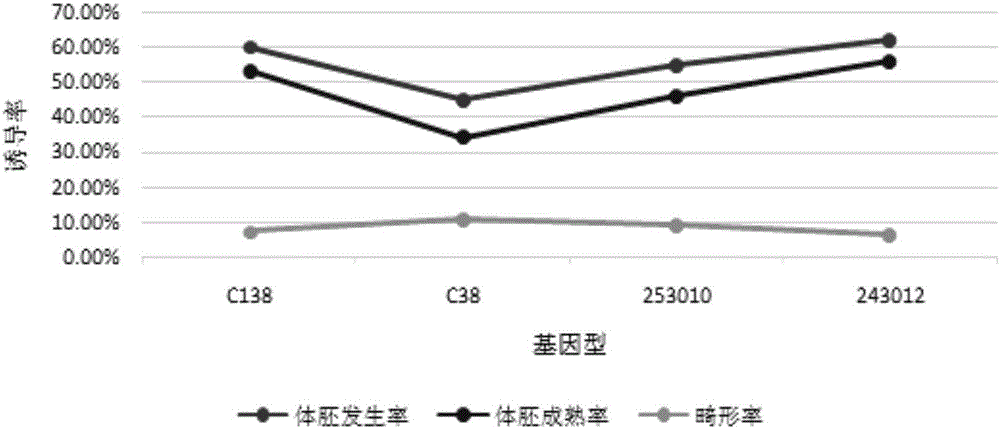Method for carrying out generation of hybridized liriodendron chinense somatic embryos by utilizing salicylic acid
A technology for hybridizing Liriodendron tulipifera and somatic embryos of Liriodendron tulipifera, applied in horticultural methods, botanical equipment and methods, applications, etc., to achieve the effects of promoting large-scale application, improving efficiency, and reducing deformity rates
- Summary
- Abstract
- Description
- Claims
- Application Information
AI Technical Summary
Problems solved by technology
Method used
Image
Examples
Embodiment 1
[0048] 1. Establishment of hybrid Liriodendron suspension system
[0049] The embryogenic callus was transferred to 250 mL of callus liquid medium for shaking culture, the culture environment was dark culture, 24 ° C, and the shaker speed was 96 rpm. Callus of each genotype was inoculated into 3 flasks, and the suspension cell culture was prepared according to the ratio of 1:9, and the volume of each Erlenmeyer flask was 50 mL after the suspension cells were mixed with the culture medium. The subculture period of the material is 7 days, and after 2 subcultures, the cells are sieved. 400-mesh single cells were shaken and cultured in a liquid-adjusted medium for 1 day, and the medium was 3 / 4MS+NAA0.2mg / L+KT0.5mg / L+BA0.2mg / L+ABA1.0mg / L+VC5.0mg / L , sugar 50g / L, hydrolyzed casein 0.5mg / L, culture environment is dark culture, 24°C, shaker speed is 96rpm.
[0050] 2. Induction of somatic embryos in liquid medium
[0051] The liquid suspension cells over-cultured for 2 days were ob...
Embodiment 2
[0065] 1) After excessive liquid suspension culture, observe the state of liquid cells of different genotypes under a microscope, such as figure 2 shown. The hybrid Liriodendron tulipifera suspension cells of genotype C138 were selected for culture. Use a pipette gun to draw 2 mL and spread it on SA somatic embryo induction medium of different concentrations (SA concentration is number 1: 0 mg / L, number 2: 0.01 mg / L, number 3: 0.05 mg / L, number 4: 0.25 mg / L, No. 5: 1.25mg / L), observed and counted the number of somatic embryo development under a microscope after 28 days, and counted the number of somatic embryo seedlings after 45 days, and the statistical results are as shown in Table 4.
[0066] Table 4 The induction of somatic embryos with genotype C138 on different media
[0067]
[0068] Note: + grows poorly, ++ grows generally; +++ grows well; ++++ grows better; +++++ grows best, the same below.
[0069] As can be seen from Table 4, adding different concentrations ...
Embodiment 3
[0092] The hybrid Liriodendron tulipifera callus was directly transferred to the solid medium supplemented with different concentrations of SA, and 5 cell blocks were connected to each dish, and 6 dishes were inoculated at each concentration. The primary culture environment was dark culture. After the callus grew out of the embryonic structure, the light environment was adjusted to light culture for 16 hours, dark culture for 8 hours, and the temperature was 24°C. The specific addition concentration is shown in Table 10.
[0093] Table 10 SA addition concentration
[0094]
[0095]
[0096] Among them, agar is 8.0g / L, hydrolyzed milk protein is 0.5g / L, activated carbon is 4.0g / L, sucrose is 40g / L, pH5.7-5.8.
[0097] The genotypes of C138, 243012, and 253010 hybrid Liriodendron callus were respectively transferred to solid medium supplemented with different concentrations of SA (Table 10). After 28 days of culture, no obvious somatic embryos appeared. After two subcult...
PUM
 Login to View More
Login to View More Abstract
Description
Claims
Application Information
 Login to View More
Login to View More - R&D
- Intellectual Property
- Life Sciences
- Materials
- Tech Scout
- Unparalleled Data Quality
- Higher Quality Content
- 60% Fewer Hallucinations
Browse by: Latest US Patents, China's latest patents, Technical Efficacy Thesaurus, Application Domain, Technology Topic, Popular Technical Reports.
© 2025 PatSnap. All rights reserved.Legal|Privacy policy|Modern Slavery Act Transparency Statement|Sitemap|About US| Contact US: help@patsnap.com



